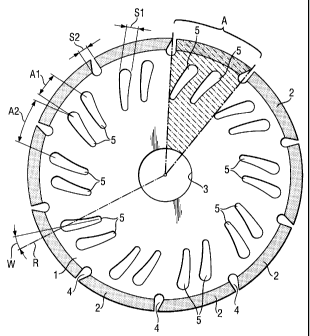Some of the information on this Web page has been provided by external sources. The Government of Canada is not responsible for the accuracy, reliability or currency of the information supplied by external sources. Users wishing to rely upon this information should consult directly with the source of the information. Content provided by external sources is not subject to official languages, privacy and accessibility requirements.
Any discrepancies in the text and image of the Claims and Abstract are due to differing posting times. Text of the Claims and Abstract are posted:
| (12) Patent: | (11) CA 2347864 |
|---|---|
| (54) English Title: | DISC-SHAPED PARTING TOOL |
| (54) French Title: | OUTIL A TRONCONNER EN FORME DE DISQUE |
| Status: | Expired |
| (51) International Patent Classification (IPC): |
|
|---|---|
| (72) Inventors : |
|
| (73) Owners : |
|
| (71) Applicants : |
|
| (74) Agent: | GIERCZAK, EUGENE J. A. |
| (74) Associate agent: | |
| (45) Issued: | 2009-09-15 |
| (22) Filed Date: | 2001-05-16 |
| (41) Open to Public Inspection: | 2002-01-06 |
| Examination requested: | 2006-04-06 |
| Availability of licence: | N/A |
| (25) Language of filing: | English |
| Patent Cooperation Treaty (PCT): | No |
|---|
| (30) Application Priority Data: | ||||||
|---|---|---|---|---|---|---|
|
A parting tool, including a disc-shaped base member, a plurality of ring segment-shaped cutting regions provided at a circumference of the base member separated circumferentially by recesses open at an outer contour of the base member and extending radially through respective cutting regions, and at least one elongate opening located in a section of the base member, which is limited by two adjacent recesses and the central bore of the base member, and extending radially along a section of a spiral line starting from a center of the base member.
Outil à tronçonner comprenant les éléments suivants : un élément de base en forme de disque; plusieurs régions de coupe en forme de segments d'anneau, placés sur la circonférence de l'élément de base et séparés sur cette circonférence par des entailles pratiquées sur le contour extérieur de l'élément de base, qui s'étendent radialement dans ces régions de coupe; au moins une ouverture allongée dans une section de l'élément de base, cette section étant délimitée par deux entailles adjacentes et par le trou central de l'élément de base. Cette ouverture s'étend radialement le long d'une section d'une ligne en spirale qui part du centre de l'élément de base.
Note: Claims are shown in the official language in which they were submitted.
Note: Descriptions are shown in the official language in which they were submitted.

For a clearer understanding of the status of the application/patent presented on this page, the site Disclaimer , as well as the definitions for Patent , Administrative Status , Maintenance Fee and Payment History should be consulted.
| Title | Date |
|---|---|
| Forecasted Issue Date | 2009-09-15 |
| (22) Filed | 2001-05-16 |
| (41) Open to Public Inspection | 2002-01-06 |
| Examination Requested | 2006-04-06 |
| (45) Issued | 2009-09-15 |
| Expired | 2021-05-17 |
There is no abandonment history.
| Fee Type | Anniversary Year | Due Date | Amount Paid | Paid Date |
|---|---|---|---|---|
| Application Fee | $300.00 | 2001-05-16 | ||
| Registration of a document - section 124 | $100.00 | 2001-07-23 | ||
| Maintenance Fee - Application - New Act | 2 | 2003-05-16 | $100.00 | 2003-04-28 |
| Maintenance Fee - Application - New Act | 3 | 2004-05-17 | $100.00 | 2004-05-11 |
| Maintenance Fee - Application - New Act | 4 | 2005-05-16 | $100.00 | 2005-05-04 |
| Request for Examination | $800.00 | 2006-04-06 | ||
| Maintenance Fee - Application - New Act | 5 | 2006-05-16 | $200.00 | 2006-04-26 |
| Maintenance Fee - Application - New Act | 6 | 2007-05-16 | $200.00 | 2007-04-18 |
| Maintenance Fee - Application - New Act | 7 | 2008-05-16 | $200.00 | 2008-05-02 |
| Maintenance Fee - Application - New Act | 8 | 2009-05-18 | $200.00 | 2009-04-27 |
| Final Fee | $300.00 | 2009-06-16 | ||
| Maintenance Fee - Patent - New Act | 9 | 2010-05-17 | $200.00 | 2010-04-14 |
| Maintenance Fee - Patent - New Act | 10 | 2011-05-16 | $250.00 | 2011-04-13 |
| Maintenance Fee - Patent - New Act | 11 | 2012-05-16 | $250.00 | 2012-04-11 |
| Maintenance Fee - Patent - New Act | 12 | 2013-05-16 | $250.00 | 2013-04-10 |
| Maintenance Fee - Patent - New Act | 13 | 2014-05-16 | $250.00 | 2014-04-09 |
| Maintenance Fee - Patent - New Act | 14 | 2015-05-19 | $250.00 | 2015-04-22 |
| Maintenance Fee - Patent - New Act | 15 | 2016-05-16 | $450.00 | 2016-04-20 |
| Maintenance Fee - Patent - New Act | 16 | 2017-05-16 | $450.00 | 2017-04-26 |
| Maintenance Fee - Patent - New Act | 17 | 2018-05-16 | $450.00 | 2018-05-07 |
| Maintenance Fee - Patent - New Act | 18 | 2019-05-16 | $450.00 | 2019-05-08 |
Note: Records showing the ownership history in alphabetical order.
| Current Owners on Record |
|---|
| HILTI AKTIENGESELLSCHAFT |
| Past Owners on Record |
|---|
| SPANGENBERG, ROLF |